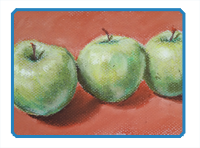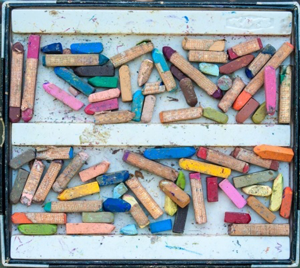
By Matt Fussell
A still life is simply an arrangement of objects that are drawn or painted from observation. Drawing or painting from a still life arrangement is good practice for enhancing and improving your observational skills as an artist. It is also great practice for learning and developing skill with specific media and techniques.
The process of making marks with soft pastels is definitely a drawing process. However, many refer to the process as painting, since the finished result often shares the characteristics of a painting. The thought process of the artist is also closely related to painting. Colors are layered and mixed as they would if they were applied with a wet medium.
 One of the great characteristics about soft pastels, also called chalk pastels, is the immediacy of the medium. The artist receives instant feedback on the colors as they are applied. Time is not spent mixing paints, as would be the case with wet media. Instead, colors can be directly applied and mixed directly on the surface, if so desired.
One of the great characteristics about soft pastels, also called chalk pastels, is the immediacy of the medium. The artist receives instant feedback on the colors as they are applied. Time is not spent mixing paints, as would be the case with wet media. Instead, colors can be directly applied and mixed directly on the surface, if so desired.
Pastels are considered by some to be a difficult medium to learn. However, I tend to believe that pastels make a great medium for those wanting to transition to a colored medium. Like colored pencils, pastels can help transition to colored media with having to deal with any stress that be arise from the thought of using paint.
A still life arrangement is not always the “most exciting subject”. I’ll be the first to admit that. However, exciting things can happen in the process of drawing or painting a still life. The goal of the work may be to produce a finished work that is aesthetically pleasing, skillfully crafted, and possibly - thought provoking. But there is more that still life subjects can offer.
It’s no secret that drawing and painting representationally is about observation. If we are the recreate the world around us in a drawing or painting, then we logically have to look at the world around us. Painting a still life helps us develop these skills of observation. When we look at a still life in order to paint it, we better understand light, shadow, form, and color. More importantly though, we better understand how to create the illusion of it all in our works.
While it may not always be possible to work from life, it is the best approach to do so. This means it is best to set up your own arrangements and work from pure observation. Doing this forces the artist to make sense of the three-dimensional physical word around them with the aid of photo, which has already “flattened” the space - so to speak.
 When arranging a still life composition, it is best to think in odd numbers. For some reason, odd numbers are just more aesthetically pleasing to us. Compositionally speaking, we would rather see an arrangement of “3” objects as opposed to “2”, or “5” instead of “4”. This is sometimes referred to as the “Rule of Odds”.
When arranging a still life composition, it is best to think in odd numbers. For some reason, odd numbers are just more aesthetically pleasing to us. Compositionally speaking, we would rather see an arrangement of “3” objects as opposed to “2”, or “5” instead of “4”. This is sometimes referred to as the “Rule of Odds”.
It is argued that when we see numbers of objects that are even, our mind attempts to pair them up. It’s no wonder why we may do this. After all, we do exist in a world of pairs. We have two ears, eyes, hands, and so on.
When we are trying to move a viewer’s eye around a work of art, seeing a “pair” may inhibit eye movement. Odd numbers of objects presented in a still life keep the minds of our viewers focused on the arrangement and allow the artist more control in how the subjects are perceived.
The still life arrangement used in this demonstration consists of three objects (apples) for this very reason. More still life arrangements (photo references) that make use of the “Rule of Odds” can be found here.
The following video art lesson demonstrates an overview on how to paint a still life with soft pastels...
Here are some more art lessons that you may like...